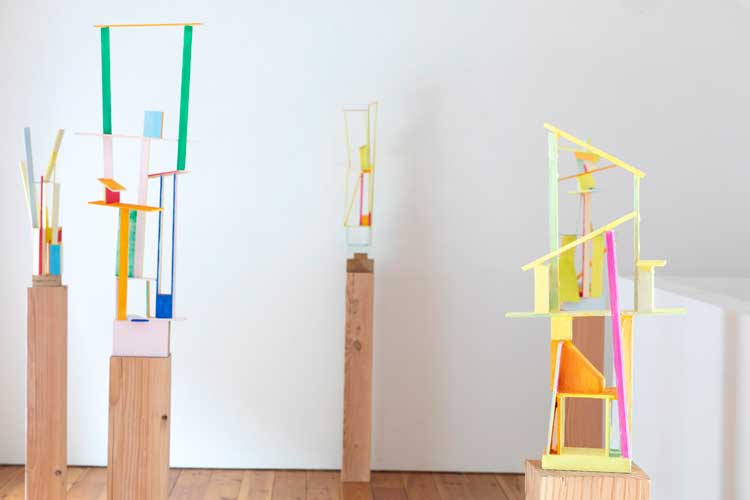
Rowan Mace: Time’s Light, installation view, Cample Line, 2023. Photo: Mike Bolam.
Cample Line, Cample Mill, Dumfries
8 July – 10 September 2023
by BETH WILLIAMSON
There is a deep and enduring sense of calm in the gallery spaces at Cample Line. This might be connected to its clean white spaces or its rural setting, but it is more than that. It is connected also to its quiet insistence on the importance of community and the local, yet it goes beyond that too. It is linked to its openness to the global, to a rigorous engagement with contemporary art that invites allcomers from the local towns and villages to those from further afield. There is no pretence here and everyone is welcome. Whether it is standing room only for an artist’s talk, or a single visitor on a wet Saturday afternoon, Cample Line is a space that seems to hold you, a space where you feel complete and can ask anything. The two current exhibitions at the gallery, both about time in one sense or another, underline this sense of completeness.
.jpg)
Amy Winstanley, Slim Glimpses, 2023. Oil on canvas, 103 x 93 cm.
In Slim Glimpses, her exhibition in the downstairs gallery, Amy Winstanley presents 13 paintings made this year. Although she is based in Glasgow, Winstanley was born and grew up around here. These paintings are unassuming. The repertoire of vibrant colours and brushstrokes sometimes shimmer in the afternoon light and they exude emotion, a simple joy, simple in the sense that they are modest and understated in what they achieve, entirely at home in this place but setting significant challenges nonetheless. There is movement and flux in the colours, shapes and textures. These “slim glimpses” are moments of memory that have absorbed Winstanley’s attention as she begins to make connections and submit to an organic process of mark-making. There is a visionary and prismatic focus on place and practice, on capturing that glimpse in time and place. The artist’s vocabulary of colour and form captures these glimpses of sensory memories in a manner that keeps them alive. Like capturing a wild animal, the risk is that captured memories or glimpses lose their vitality, fall dead on the canvas. In these paintings, however, the artist keeps them alive with loose and generous brushstrokes, a glimpse of hopefulness in troubled times. Winstanley is interested in ideas of entanglement so that everything in the universe is entangled, nothing exists in isolation. Here, she references the writing of the feminist theorist Donna Haraway and others. One of the lines she has picked out from Haraway’s 2016 book Staying With the Trouble) makes sense of the paintings here: “To stay with the ragged joy of ordinary living and dying.”
.jpg)
Amy Winstanley, Reverberative Business, 2023. Oil on canvas, 93 x 103 cm.
It is perhaps Winstanley’s ecology of living hopefully in the world, connected to all things, that enables her to paint with such optimism. Everything feeds into painting. She begins in a sketchbook, to loosen up and take stock, she says. Activities vary between sketching, reading, writing, moving and painting. Working on multiple paintings at once, she consciously changes her palette as she goes. The paintings work individually and coalesce as a group, entangled with artist, viewer, time and place. Calling the outside in, bringing human and non-human together for a moment, a tentacular practice that requires sympoiesis or, to borrow from Haraway, “making-with”, a collective means of creation or organisation. In this respect, Winstanley’s paintings might be understood as the product of a collective consciousness and a quiet call to action, to live differently in the world by recognising and acknowledging our complex, dynamic and responsive entanglement with everything everywhere.

Rowan Mace: Time’s Light, installation view, Cample Line, 2023. Photo: Mike Bolam.
Running concurrently with Slim Glimpses at Cample Line is Rowan Mace’s exhibition Time’s Light. Mace’s sculptures populate the airy upstairs gallery while some of the smaller pieces occupy the bookshelves downstairs. Mace is based in Glasgow but was born and grew up in Cornwall. It is obvious to wonder whether her preoccupation with changes in the light has its origins in the Cornish landscape, or the work of the St Ives School of artists whose mid-20th-century abstraction was inspired by that same landscape. Mace works with wood to build structures that she then paints. She explains a seasonal process that means she builds her wooden structures in the autumn and winter when light is at a premium, and then paints them in the spring and summer when light is in abundance.

Rowan Mace, Untitled, 2022. Oil paint on wood, 45 x 45 x 14 cm. Photo: Ocean Teale.
This is about looking intensely, becoming almost outside of time, she says. I take this to indicate a kind of submission to the work, time frozen, just being, not doing. Except she is doing, working intuitively and calmly, playing with balance as she makes these wooden structures, pushing geometries almost to the point of collapse, but not quite. Mace tries to keep the mood as spontaneous as possible and, is curious about what influences feeds into her work – that kind of self-reflexive question is evident in the work, too. She is interested in the edges of things and these fragile, fugitive architectures exist at the limit of what is possible, the edge of reason. Their warped geometry made me think of “the geometry of fear”, that term coined by the critic Herbert Read in 1952 to refer to sculpture immediately after the second world war, characterised by tortured, broken and blasted human and animal bodies. Mace’s sculptures are the antithesis of these and might be thought of as embracing a geometry of calm, a time and space when we can feel held by the form, when we can experience the silence in objects.
Still, these sculptures are not only about form, they are equally concerned with colour and light. Light changes appearances all the time. Mace paints these structures as if they were canvases, creating space and contrast that is dependent on how different colours sit alongside each other – in harmony or dissonance. The surfaces are painterly, as the artist works intuitively, the sheer enjoyment of applying the paint, and searching, unconsciously, for the colour and degree of painterliness required in each instance, the oiliness or chalkiness of the paint. It is surely no coincidence that Mace trained and practised as a Gestalt therapist for a decade (2002-12). The work that she presents here, made in 2022 and 2023, is all untitled, whole in itself and without need of a title to justify its existence.

Rowan Mace: Time’s Light, installation view, Cample Line, 2023. Photo: Mike Bolam.
As the artist explains: “The pieces work in relation to each other, the viewer and the environment creating an intimate world concerned with internal and external space.” Those pieces rendered in a single colour, often soft pink or baby blue, appear more open to the light around them, casting shadows, scattering thoughts. In their multicoloured companions, light works internally, focused at its core, as if ready to power a lightbulb. These two different ways of responding to the light around them each creates a different result for the viewer. Yes, in each case it focuses attention but the multicoloured sculptures require an acuity of vision, a critical degree of attention, while those works made in a single colour engender a more dispersed form of attention in the viewer. Either way, they gently coax our attention like an attentive parent. The encourage our eyes to play across their surfaces, to notice how the changing light falls on them, and to find memories and imagined futures, as well as moments of presentness, out of time and complete.
Of course, completeness does not mean complacency. Rather it is an experience of being enough, of shared humanity and valued individual differences. It is a sense of cohesion and community and being permitted to speak on your own terms. That is precisely what Mace and Winstanley do in their respective bodies of work here and it is exactly what Cample Line facilitates. If you haven’t spent time in this place yet, then you really should.